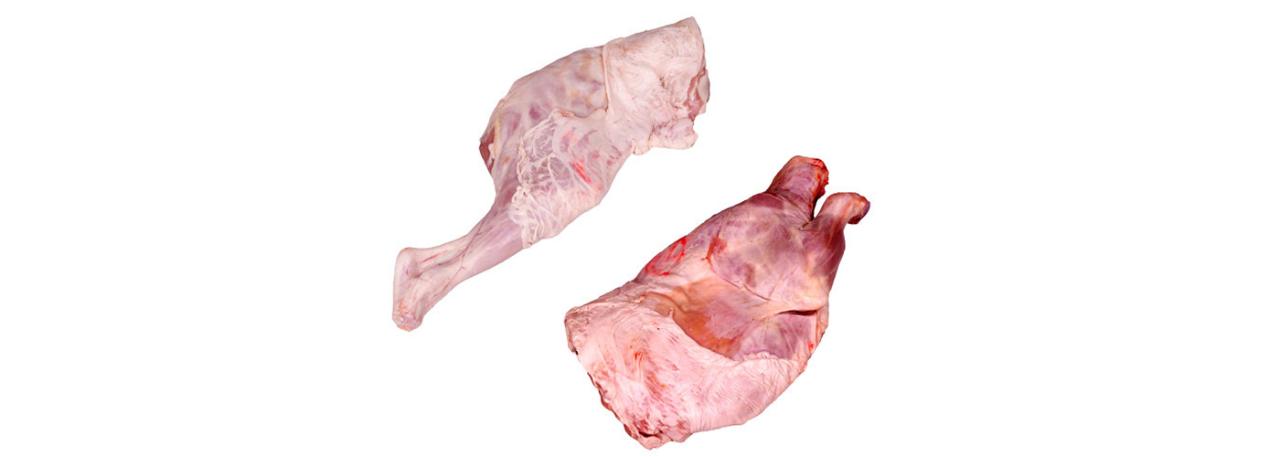.png.transform/rendition-xs/image_image%20(1).png)
Milk-fed lamb from the Basque Country
Meat from lamb from the Latxa and/or Carranzana breeds (native to the Basque Country) and their crosses.This product is protected by the Eusko Label quality stamp awarded by the Kalitatea Foundation, a non-profit foundation created for the purpose of managing and promoting quality labels for food products from the Basque Country.
The quality certification is awarded to all lambs which are born, bred, slaughtered and butchered in the Basque Country. They must be slaughtered at an age of between 21 and 35 days. These lambs are fed with maternal milk, reared in a natural environment, and slaughtered when they have a dressed weight (with head and innards) of between 5-8 kg / 11-17,6 lb, which results in tender succulent meat with a pearly white to pink color. The dressed animals are individually marked for identification.
Tasting notes
The color of the meat ranges from pearly white to pink, and it has a firm and juicy texture.
Other notes
The color of the meat ranges from white to pink. It has a distinctive consistency and juiciness, and is usually tender.
Production / Processing method
Milk-fed lamb from the Basque Country is reared and slaughtered in that region and on farms and in slaughterhouses authorized by the corresponding regulatory board. The animals are individually identified as established in the regulation. The lambs must be fed exclusively on natural maternal milk. The lambing period is generally between November to May, and the slaughtering period is from 21 to 35 days after birth.
The animals must be slaughtered as specified by the regulation, taking the utmost care to prevent any suffering by the lambs from the time they are transported to the slaughterhouse until the slaughter itself. The vehicles must be cleaned and disinfected between batches and in all cases at the end of each day. On their arrival at the slaughterhouse the animals are unloaded and carefully led to the stabling areas, using methods designed to prevent the appearance of bruises and wounds and to minimize stress. The Kalitatea Fundazioa foundation may establish minimum and maximum stabling periods before slaughter.
All the dressed lambs are identified in compliance with the requisite defined by this regulation established by the Kalitatea Fundazioa Foundation, as are any butchered products; in all cases the four quarters of the dressed lambs must be identified.
The Kalitatea Fundazioa Foundation carries out a control of the labels and containers bearing the Euskal Esne Bildotsa stamp in order to monitor its correct use, to guard against imitations and to ensure that the labeling or presentation does not in any way damage the prestige of the guarantee stamp or contravene any of its objectives.
Geography / Relief and climate:
The Basque Country borders on the Cantabrian Sea and France to the north, the regions of Cantabria and Castile-Leon to the east, Castile-Leon and La Rioja to the south, and Navarre to the west. It is at the far east of the Cantabrian coast of the Iberian Peninsula and ends in the southern part of the Bay of Biscay. This region is located in southwest Europe in the space between the Aturri and Ebro rivers.
It has an area of 7,235 km2 and is divided into three provinces: Álava (3,037 km2), Vizcaya (2,217 km2) and Guipúzcoa (1,980 km2). There are distinct climatic areas in the Basque Country: the northern valleys, in Vizcaya and Guipúzcoa and also the valley of Ayala in Álava, where oceanic climate is predominant, with its wet weather all year round and moderate temperatures. The middle section has a more Continental Mediterranean climate, but with some influence of the northern oceanic one, this causes dry and warm summers and cold and snowy winters. The Ebro valley has a pure Continental Mediterranean climate, winters are cold and dry and summers very warm and dry, with precipitation peaking in spring and autumn.
Milk-fed lamb from the Basque Country is reared and slaughtered in that region.

